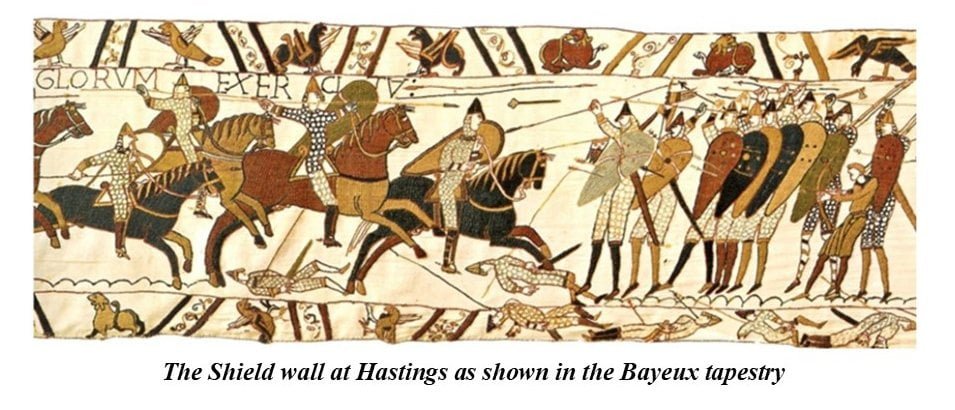
Today when a demonstration that goes nasty, we see the police build a shield wall to defend themselves and then slowly move it forward, but when checking our musical 1066 – The Battle of Hastings I realised that the shield wall as been a policy used by armies for hundreds of years.
Harold used it twice, initially in the Battle of Stamford Bridge, where it worked, then in the Battle of Hastings to defend his position at the top of a hill. While the wall was in place, he was unbeatable, William had to find a way to make the wall to collapse. He did it by putting out a rumour that, he had died, at which point the wall collapsed as Harold’s men thought they had won, which allowed William’s men to overcome them. The wall broke and history changed!
They used it before that
Even before that the ancient armies of Persia, Greece and the Roman Legions all used them. There are no records as to who first used the tactic, I think it was a natural form of defence used by armies over time. In fact when in the seventh century BC shield walls were being used by the ancient Greeks, with their shield wall, soldiers were called hoplites, the name of their shields.
Each civilisation had slight differences, but they were actually only variations of a wall of shields formed by standing shoulder to shoulder, with each shield abutting or overlapping giving each soldier protection from both his neighbours’ shields and his own.
Today
Of course, today it cannot be used in modern warfare, bullets became the problem, however it has developed into an essential tactic today for modern police forces to manage demonstrations. It has become essential protection when demonstrators use improvised weapons, punches, kicks, and throw objects such as bricks, bottles, and Molotov cocktails.
Isn’t it amazing that a military tactic that is hundreds of years old is still in daily use today?

Click on “1066 – The Battleof Hastings” a musical published by our sister site Educational Musicals .
You can put on this 50 minute musical about the battle. It is a show where there are no more than 5 lines in each speech making it easy to rehearse and put on.
Click on “1066 – The Battleof Hastings” where you can hear two of the songs and read two pages of script.
Isn’t history fascinating?
10 questions to discuss:
- Compare and contrast the effectiveness of the shield wall used by Harold at Hastings with those used by ancient civilizations like Persia and Greece.
- Analyze the specific tactics William the Conqueror employed to break through the English shield wall at Hastings.
- Discuss the evolution of the shield wall concept from ancient warfare to modern police crowd control tactics.
- Evaluate the limitations of the shield wall in modern warfare due to advancements in weaponry.
- Explore the psychological impact of facing a shield wall, both for attackers and defenders.
- Compare the shield wall to other defensive formations used throughout history, such as phalanxes or Roman testudos.
- Imagine you are a soldier in a shield wall formation during a battle. Describe your experiences and emotions.
- Discuss the ethical considerations involved in using shield walls for crowd control in modern protests and demonstrations.
- Reflect on the broader significance of the shield wall as a symbol of both defensive strength and the enduring ingenuity of military tactics.
- In your opinion, are there any potential future adaptations or applications of the shield wall concept in warfare or other contexts?
To find out more about shield walls click here:

